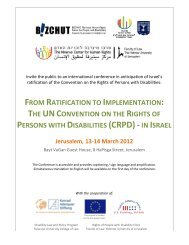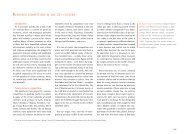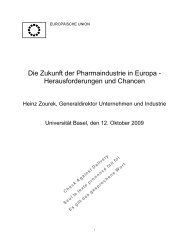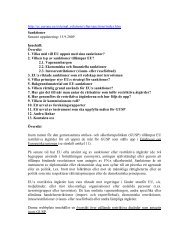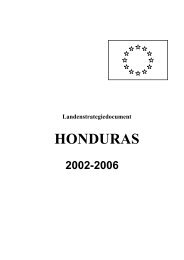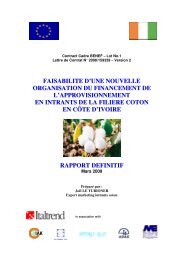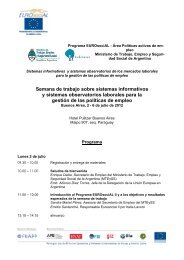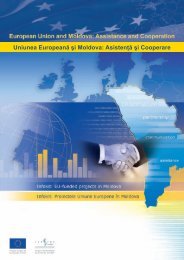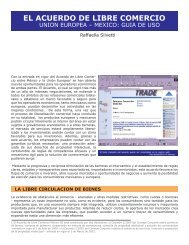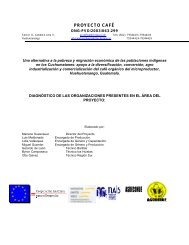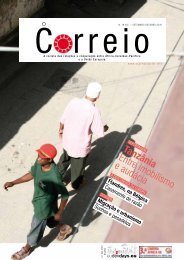Vision Group Report: Invigorating the Indonesia-EU Partnership
Vision Group Report: Invigorating the Indonesia-EU Partnership
Vision Group Report: Invigorating the Indonesia-EU Partnership
You also want an ePaper? Increase the reach of your titles
YUMPU automatically turns print PDFs into web optimized ePapers that Google loves.
<strong>Indonesia</strong>’s automotives industry has potential to become a big player on <strong>the</strong> world market. During <strong>the</strong> last 5 years,<br />
<strong>Indonesia</strong>’s market and production of cars and motorcycles has grown around 7-8% a year.<br />
<strong>Indonesia</strong> is in a very strong position to become <strong>the</strong> largest car manufacturer in ASEAN because of its strong domestic<br />
demand, skilled labour, and growing component industry. The large size of <strong>the</strong> <strong>Indonesia</strong>n population and <strong>the</strong> low<br />
level of car ownership in <strong>the</strong> country suggest <strong>the</strong>re is a lot of potential for expansion for <strong>the</strong> automotive industry. For<br />
example, in 2007, only one in every thirty-five people in <strong>Indonesia</strong> owned a car, compared with one in fourteen in<br />
Thailand and one in seven in Malaysia.<br />
Automotives industry in <strong>Indonesia</strong> consists of several assemblers of various types of cars and motorcycles and<br />
hundreds of component producers. <strong>Indonesia</strong> is a production base for multi-purpose vehicles and light commercial<br />
trucks. Domestic manufacturers serve as <strong>the</strong> assemblers for foreign, primarily Japanese, motor vehicle companies.<br />
In general, <strong>the</strong> main activity of <strong>Indonesia</strong>n automotive companies is assembling, ei<strong>the</strong>r intermediate goods (parts of<br />
motor vehicles) or final goods (cars and motorcycles).<br />
Investment in production facilities, geared in part towards <strong>the</strong> export market, has become increasingly common.<br />
Vehicle export volumes, primarily to Malaysia, Thailand and Japan, are relatively low, but are beginning to rise, as<br />
<strong>Indonesia</strong>’s importance as a production base within <strong>the</strong> Sou<strong>the</strong>ast Asian region increases. Toyota Astra, a subsidiary<br />
of Japan’s largest carmaker Toyota, accounts for about 90 percent of <strong>the</strong> <strong>Indonesia</strong>n car exports.<br />
European carmakers are under-represented in <strong>Indonesia</strong>. <strong>Indonesia</strong>n auto industry consists of mostly Japanese<br />
manufacturers. According to <strong>the</strong> Association of <strong>Indonesia</strong> Automotive Industries Gaikindo <strong>the</strong>re was only one European<br />
car manufacturer in <strong>Indonesia</strong>, Mercedes-Benz, who belonged 100% to German Daimler AG and manufactured<br />
Mercedes-Benz cars in <strong>Indonesia</strong> (annual capacity 20,000 units). Japanese cars also dominate <strong>the</strong> domestic motor<br />
vehicles market. Out of <strong>the</strong> 750 000 cars sold in <strong>Indonesia</strong> in a year, only 5000 are European (mostly Mercedes Benz<br />
and BMW).<br />
The future of cars lies in environmentally friendliness and energy saving. <strong>Indonesia</strong> plans to follow in <strong>the</strong> footsteps of<br />
Thailand by offering incentives for <strong>the</strong> production of fuel-efficient cars. European car manufacturers have <strong>the</strong> knowhow<br />
and state-of-<strong>the</strong>-art technology for modern car production and <strong>the</strong>y are willing to invest in <strong>Indonesia</strong>.<br />
The European Automotive Industry is a leader in <strong>the</strong> global automotive market, with integrated automobile operations<br />
that combine research, design, development, production and sales. It has a dense worldwide network of joint ventures,<br />
production and assembly sites. Europe is <strong>the</strong> world’s largest vehicle producer with an output of over 15 million<br />
passenger cars, vans, trucks and buses per year, or 25% of worldwide vehicle production (China produces 23%, NAFTA<br />
14%, Japan 13%, South Korea 6%, and <strong>Indonesia</strong> 0.9% of <strong>the</strong> world’s total). Leading in high-quality products, <strong>the</strong><br />
industry sells and produces vehicles in all major world markets.<br />
The automotive sector is Europe’s largest private investor in R&D. According to <strong>the</strong> <strong>EU</strong> Industrial Investment Scoreboard,<br />
<strong>the</strong> sectors ‘automobiles and parts’ and ‘commercial vehicles and trucks’ represented R&D investment of 46 billion<br />
USD in 2008. In 2008, almost 6,300 patents were filed by <strong>the</strong> European automotive industry. They made up 55% of all<br />
automotive applications at <strong>the</strong> European Patent Office. 23% of automotive applications came from Japan, 16% from<br />
<strong>the</strong> US, 1% from China/Taiwan and 1% from South Korea.<br />
Volkswagen has expressed interest in making <strong>Indonesia</strong> its production base. Volkswagen officials have stated that <strong>the</strong>y<br />
would build a factory in <strong>Indonesia</strong> in 2012 for a full car manufacturing, while in 2010 <strong>the</strong>y already started assembling<br />
its MPV, Touran, in cooperation with Indomobil.<br />
86<br />
XVII AUTOMOTIVES




